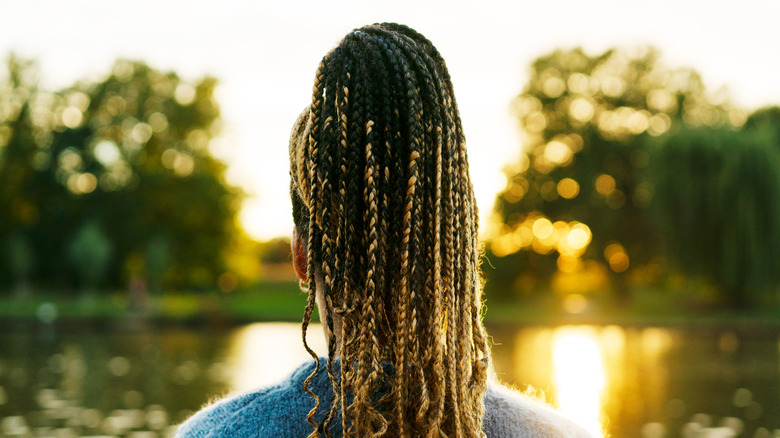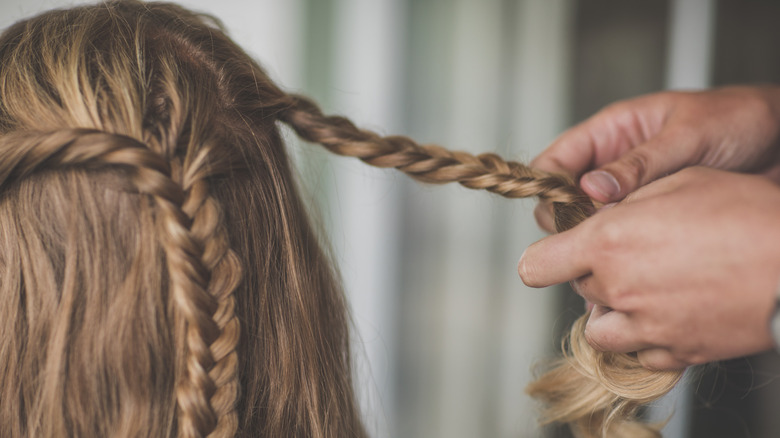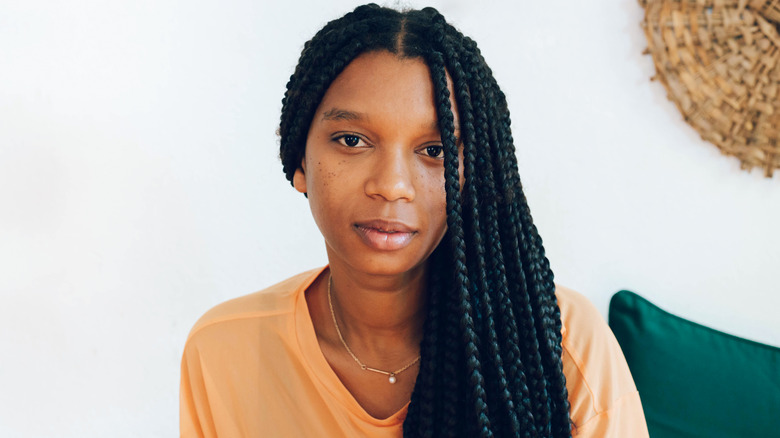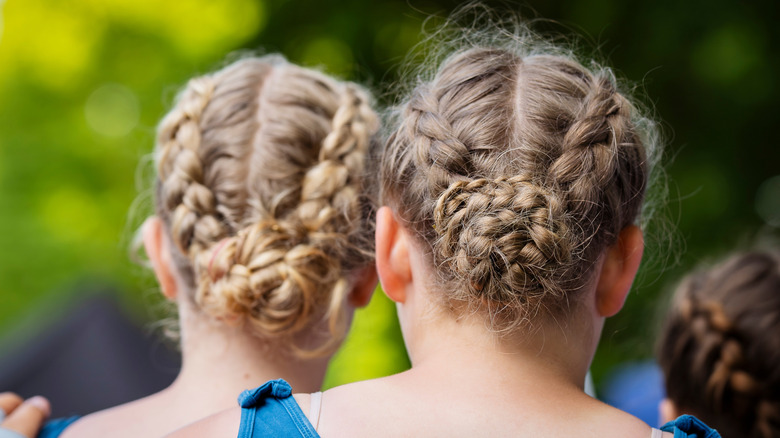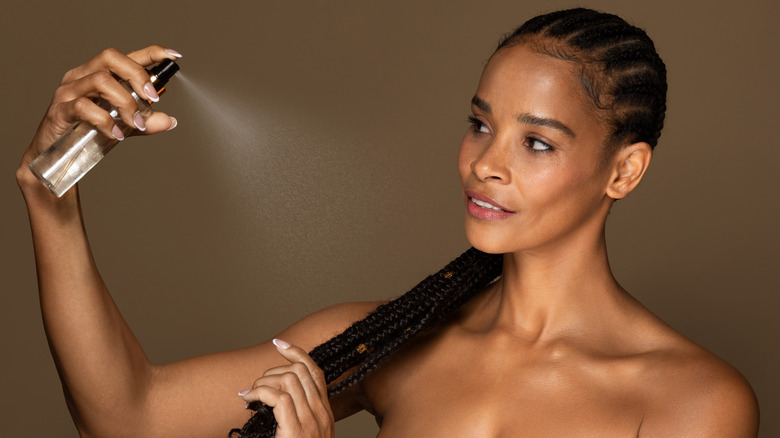What Happens If You Constantly Wear Your Hair In Braids?
Few things compare to the feel of newly done braids — the shine, the bounce, that squeaky-tight scalp, it's the hair equivalent of stepping out of a limo in slow motion. As a textured-hair girly, I basically live in braids. From plaited Bantu knots to cornrows to box braids, I'm always down for chic braided hairstyles that look amazing and work for everyday wear.
But braids aren't just for textured hair. Styles like French, dragon, and crown braids are culturally appropriate and work just as well for non-kinky textures. This brings many of us to wonder what actually happens when you never give your hair a break from braids.
Since I absolutely cannot do without them, I was excited (and slightly nervous) when Glam scored an exclusive with trichologist Ladosha Wright. As a salon owner, author, and haircare brand RevAir's resident expert, she was the perfect person to answer my burning question: Is having a braid obsession harmless or low-key sabotaging my scalp? According to Wright, braids aren't inherently damaging to the scalp if applied and maintained properly, and "they can help minimize daily styling time, reduce hair manipulation, and serve as a medium for cultural and artistic expression." However, despite the many advantages, leaving them in the same spot without changing them up every four weeks can lead to strain and even hair loss.
Are braids really a protective style?
One of the most popular "facts" about braids is that they protect your hair. But to get to the bottom of the myth, Ladosha Wright exclusively walks us through an important question: What even is a protective hairstyle? By definition, a protective style is one that reduces damage and stress on the hair by limiting friction, manipulation, and exposure to harsh environmental conditions.
"From a trichology perspective, the term protective styles may not accurately reflect the role of braids in hairstyling," she says. Wright explains that while braids reduce strain compared to curled, straightened, waved, or flipped styles, that doesn't automatically make them protective. Hang-down styles, for example, are one of the most popular types of braids. And anyone who's gotten these braids, especially with extensions, knows the manipulation doesn't stop after installation.
Packing them into different updos, styling, or even letting them hang freely are just some of the various ways we strain our hair while wearing braids. Repeated packing of the hair puts strain on the base of the braid at your scalp. Plus, with braids, the scalp isn't shielded from the elements either. "Currently, there is limited explanation from hair professionals regarding how braids may protect hair, or specifically what factors braids might provide protection against," Wright points out, adding that keeping braids in for longer than four weeks can leave hair matted. That's not exactly the "protection" most people have in mind.
What happens if you constantly wear your hair in hang-down braids?
Although trichologist Ladosha Wright makes it clear that braids aren't truly protective styles, she's quick to note that they aren't dangerous either: "Braids typically do not cause hair damage because the strands are secured together." Still, if you constantly wear hang-down braids, especially with extensions, a few issues can creep in. For one, leaving the same braided style in for more than four weeks can lead to buildup. "Hair often accumulates debris such as lint from scarves, pillowcases, hoods, and other fabrics that come into contact with it," Wright explains during our exclusive chat.
The risk is even higher if your stylist uses certain products to achieve that snatched look. Gel, for example, can actually cause hair damage the longer it's left in. Most kinky hair girlies already know the workaround: Take out the braids every two to three weeks, wash, and reinstall. But even that cycle isn't risk-free. If your stylist repeatedly parts your hair in the same places, the constant exposure, stress, and manipulation in those spots can weaken follicles over time, leading to thinning and eventual breakage — true story. It took two years and a big chop to fix the hair damage I developed thanks to hang-down braids that were placed in the same spot repeatedly.
And then there's styling strain. Pulling your hang-down braids into tight updos, half-up styles, or ponytails can twist strands at the root and add extra tension. The good news is that all of this is preventable with a bit of mindfulness. Book a stylist who understands your hair type and braids with scalp health in mind, switch up parting patterns between installs, and if you're a true braid addict with textured hair, rotate in other hairstyles that complement kinky and curly hair without putting stress on your scalp.
But, what about other types of braids that don't hang down?
Cornrows, French rolls, and even the classic double braid hairstyle are some braided styles that involve less manipulation than hang-down styles. They're fixed in place, with ends tucked and strands shielded — so what could go wrong? According to Ladosha Wright, trouble starts when they're left in too long. "When braids are worn for extended periods (i.e. longer than four weeks), they may appear lifted away from the scalp," she explains.
Beyond that, even these low-manipulation styles can be ruined by poor technique or the wrong products, including heavy pomades and waxes. "Excessive or improper use of hair products can interfere with effective braiding, altering the appearance of the braid and causing it to become oily, waxy, bulky, or uneven in pattern," she says during our exclusive chat. And just like with hang-down braids, repetitive parting in the same spot can still lead to thinning and hair loss over time.
The fix is to switch up your braid styles and choose a stylist who actually knows how to braid without compromising scalp health. Beyond that, invest in your at-home hair care. Learn how to use a detangling brush if you're a curly girl and look into care tips like the maximum hydration method for super curly hair to keep strands strong and supple between installs.
How to care for your hair while wearing braids
One of the biggest takeaways from our exclusive chat with trichologist Ladosha Wright was how to keep your hair healthy while living in braids. "Proper maintenance of braided hairstyles involves applying a hydrating spray nightly and securing the hair with a satin or cotton scarf," she explains. Wright swears by scarves over bonnets because those elastic bands can cause friction, which eventually leads to hair loss. The goal is a nighttime hair routine that keeps friction, thinning, and breakage far, far away by letting your tresses rest in peace. One way to achieve this is by using an important tip she shares with her patrons: "At the salon, clients are advised to use a leave-in such as RevAir's Hydrating Leave-In Conditioner each evening."
This conditioner has a blend of coconut water, hyaluronic acid, and olive leaf oil, which keep the hair "well-hydrated and protected." Plus, it has a trigger spray that makes application so much easier. Beyond products, a key part of caring for your hair is taking your braids out the right way. From one braid lover to another, the ultimate secret is to use these tricks for detangling fine hair without causing damage, even if you do not have fine hair. Start by working on dry hair (never wet) and using a detangler or plain water. Use your fingers to patiently loosen knots and matting before a comb ever touches your head. Your hair will appreciate gentleness more than you know. Finally, when it's comb time, stick to a wide-tooth comb or a detangling brush and comb from the ends to the roots. Every strand matters, so skip the rough handling.
If you're reading this a little too late and the damage is already done, don't panic. It's never truly too late to turn things around. Start a haircare routine tailored to your texture, stick to quality salons, and add a scalp serum, which is a haircare staple, to your lineup. Trust us, your hair will thank you.
